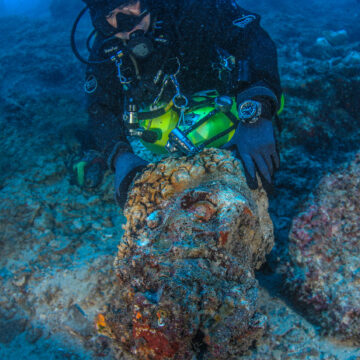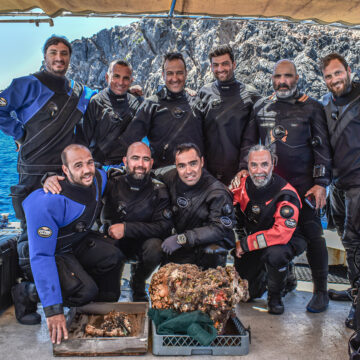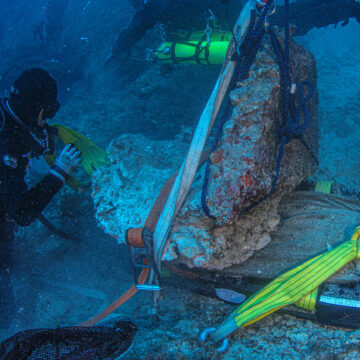Return to Antikythera 2022
The second season (May 23-June 15, 2022) of the underwater archaeological project on the Antikythera shipwreck, which is part of a five-year research program (2021-2025), was successfully completed. It provides a striking link between contemporary research and the iconic diving operations of 1900-1901.
The project is conducted by the Swiss School of Archeology in Greece under the direction of Dr. Angeliki G. Simosi, head of the Ephorate of Antiquities of Euboea, and Lorenz Baumer, Professor of Classical Archaeology at the University of Geneva. Underwater operations are placed under the supervision of the Ephorate of Underwater Antiquities, while the project is held under the patronage of H.E. the President of the Hellenic Republic, Ms Katerina Sakellaropoulou.
The main objective of the program is to formulate a clearer and more precise understanding of the ship, its route, its cargo, and the conditions of the shipwreck.
The 2022 field research included the relocation of selected sizeable natural boulders that had partially covered the shipwreck area during an event that is under investigation, weighing up to 8.5 tons each. Their removal gave access to a formerly unexplored part of the shipwreck. A customized setup consisting of durable rigging, underwater lifting bags and pressurized air supply conceptualized and developed by the Hublot Xplorations team, of the well-known Swiss watchmaker.
Official website:
Antikythera Research program on ESAG website:
A handful of discoveries
- Plinth of a marble statue, including the lower parts of the legs, covered by a thick layer of marine deposits. The first steps of cleaning and restoration will reveal further details regarding its identification and analysis.
- Marble head of a male bearded figure, bigger than life-size, which at first sight can be identified with Herakles (Hercules) of the so-called Farnese type. It most probably belongs to the headless statue of the so-called “Herakles of Antikythera”, inv. no. 5742 of the National Archaeological Museum, which sponge divers retrieved in 1900.
- Significant information is expected to be extracted from two human teeth, discovered in a solid agglomerate of marine deposits together with fragments of copper, wood, and other materials typical of a shipwreck. Genetic and isotopic analysis of the teeth might be useful to deduce information on the genome and other characteristics relevant to the origin of the individuals they belonged to.
- Numerous objects from the ship’s equipment, such as bronze and iron nails, a lead collar of a sizeable wooden anchor, and amorphous iron concretion masses covered by marine deposits have been also recovered. X-ray and other specialized laboratory analysis will help identify their function.
The exact position and the archaeological context of each finding were precisely documented during excavation and will be integrated into the 3D model of the site that is under development since October 2022. Samples of sediments were collected from predetermined areas of the seabed, allowing for a microanalysis that will lead to a better knowledge of the dimensions and precise position of the shipwreck. Together with the ongoing artifacts analysis, the newly applicable microarachaeological practices will enhance the ability to precisely reconstruct the disposition of the wreckage and the conditions of the ship’s sinking sometime during the first half of the 1st century BC.
The latest findings have been safely transported to the facilities of the Ephorate of Underwater Antiquities of the Hellenic Ministry of Culture and Sports, following an initial treatment under the supervision of the Ephorate’s Conservation Department
An international team
Research in the field has been directed by Alexandros Sotiriou, associate researcher at the University of Geneva. The scientific personnel was additionally manned by Carlo Beltrame, professor at the University Ca’Foscari of Venice, Dr. Elisa Costa, a researcher at that same university, Orestes Manousos (MA) and Dr. Isaac Ogloblin, and the specialized divers Haralambos Mitrou, Dimitris Romios, and Nikolas Giannoulakis who was also engaged with underwater photography utilized during 3D modeling. Four members of the Underwater Missions Unit of the Hellenic Coast Guard, Aris Machairidis, Dimitris Hatziaslan, Dimitris Kiosis and George Lytrivis daily also participated in the fieldwork. Technical support was provided by the members of the Hublot Xplorations team Mathias Buttet, Michel Blumenthal, Aloïs Aebischer, and Diego Carven. The laboratory equipment for on-site analyses has been provided by the Faculty of Sciences of the University of Geneva (Laboratory of Crystallography and Department of Earth Sciences). The architect-diver of the Ephorate of Underwater Antiquities, Aikaterini Tagonidou, supervised all fled work activities on behalf of the Hellenic Ministry of Culture and Sports. As in former years, the project greatly profited from the supply ship “Typhoon,”, provided by the A. C. Laskaridis Charitable Foundation. The coordination with its crew was led by Rear Admiral (retired) Alexandros Palatianos. The main supporters of the research program are the Aikaterini Laskaridis Foundation and the Swiss watchmaker Hublot. The research is also funded by the Nereus Research Foundation, which was established in Geneva with the primary purpose of supporting the Antikythera shipwreck research program. Telecommunications were supported by COSMOTE. Special thanks are due to Mr. Panos Laskaridis and the mayor of Kythera and Antikythera, Efstratios Charchalakis, for their continuous support, as well as to the residents of the islands of Antikythera for their hospitality.
Contacts
• Lorenz Baumer
Professor of Classical archaeology
University of Geneva
+41 22 379 71 23
+30 698 023 4334
Lorenz.Baumer@unige.ch
• Sylvie Fournier
Head of communication
Swiss School of Archeology in Greece
+41 78 890 04 20
communication@esag.swiss
Press release
ESAG Press release (En/Fr/De) Antikythera website









